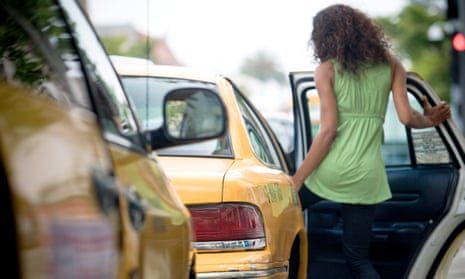Vivi Restuviani would try to make herself look as invisible as possible when she was out at night in her former hometown of Semarang, Indonesia. “If you looked at me from behind, you’d probably have thought I was a boy,” she says.
One night, Restuviani was taking her regular short walk home, swamped anonymously in an oversized hooded sweater. As she walked along the main drag, she heard a motorbike approach; suddenly its rider was in her face.
“He was trying to talk to me but I knew this guy wanted something else,” she recalls. “You know there’s that moment when you are being harassed, and you stop being surprised or shocked and just scream? Well, that isn’t what happened. I said nothing and then he started groping me.”
Finally, Restuviani managed to pull away and run towards a security guard, while her attacker sped off unchallenged into the night. “I was trying so hard to scream,” she says. “I tried so hard – but I couldn’t.”

In almost every country in the world, women walk disproportionately fewer steps each day than men, according to a recent Stanford study which analysed the smartphone data of 717,527 people worldwide over 68 million days of activity.
While media coverage focused on the overall results (generating headlines such as Do YOU live in the world’s laziest country?), the study shed new light on an important health inequality issue. The researchers found that high “activity inequality” – where a country has a wide gap between those who walk a lot and those who walk very little – was a strong predictor for a nation’s obesity levels among the 47 countries studied.
Furthermore, the “gender step gap” between men and women was typically widest in high-obesity countries – putting women at greater risk of exercise-related health problems later in life.
In Sweden, the researchers found virtually no gender gap, with men and women walking roughly the same average number of steps each day. Yet in Qatar, women walked 38% fewer steps a day on average than their male counterparts.
“If one person doesn’t walk a whole lot, maybe they’re lazy. If hundreds of thousands of people – and especially women – don’t walk a lot? That’s not an individual laziness problem, that’s a societal problem,” says the Stanford study’s lead researcher, Tim Althoff.
“One thing that is clear is that, on average, women are not as tall as men – so that typically translates into shorter legs. If you are shorter, you actually have to take more steps.”
There could be many reasons for the gender step gap, Althoff says, from differences in cultural gender roles to urban environmental issues (the researchers found the difference in step counts between men and women diminished greatly in cities with higher “walkability” scores).
However, talk to women all over the world about their walking habits, and one issue comes up again and again: personal safety.

Frightened off her feet
In Washington DC, non-profit worker Hannah Geyer has all but given up her regular 15-minute walk through a park to and from the venue where she performs in a variety show. The groups of men who loiter in the park have literally frightened her off her feet.
“They would get really, really, really close to me,” Geyer says. “It’s one thing if you’re yelling at me from across the sidewalk, because I can just be, like, ‘whatever’ and keep walking. But physically putting their bodies into my path or getting into my bubble when I don’t answer or look irritated at them – which is all the time ... It was [them saying]: ‘I’m gonna stop you from walking where you’re walking.’”
Now Geyer takes ride-share cars, paying US $5-10 each time. But she is adamant that if she still felt safe enough to walk, she would.
“I’ve noticed that, because I tend to take cars such short distances, guy friends will go: ‘Oh my god, you should have just walked, you’re so lazy’,” Geyer says. “I think it’s funny that to men it can come across as lazy, when it’s so obvious to women that it’s self-preservation. I’ve never got that comment from a woman.”
Feeling forced to use transport instead of walking makes safety a privilege, according to Stop Street Harassment founder Holly Kearl. Women can only choose not to walk if they have the financial means to access transport – which means for teenage girls in particular, cost can be a barrier to safety.
A report released last month by the Children’s Society showed one in three girls aged between 10 and 17 in Britain said they felt afraid of being followed by strangers. Multiple girls described being “beeped” at while in their school uniforms by men driving past.
“We know so many women feel they have to take public transit, or pay for a taxi, or drive and pay for parking wherever they’re going,” says Kearl. “There are definitely ways in which women are paying to stay safe.”

PhD student Natalie Jester says she sometimes “feels like prey” after dark in central Bristol. She will regularly spend her wages on a cab or bus home to avoid walking in the centre, where she can feel threatened by the groups of men milling about drinking.
“I feel really resentful that I don’t feel safe enough to walk around my city, to the point that I have to pay extra money,” Jester says. “I don’t think men really understand the degree to which women feel unsafe.”
Women may also be paying with their health. According to Public Health England (PHE), English people are 20% less active today than they were in the 1960s – with each person walking, on average, 24km (15 miles) less per year. And the Stanford researchers found that UK women took 1,074 fewer steps on average than men every day – adding up to almost 400,000 fewer steps a year.
According to PHE’s One You walking campaign adviser, Professor Sir Muir Gray, this leads to further health inequalities, owing to the sedentary nature of many jobs today. “Poor people ... are now often less active than wealthy people, because poor people work more often at these dreadful desk jobs,” Gray says. “In general, that contributes to the social divide.”
The threat of harassment
Ever since she was assaulted in Semarang, Vivi Restuviani has had to work hard at regaining the confidence to walk in public alone. The few hundred yards she walks as part of her daily commute in Jakarta, her new home city, used to come with an unwanted chorus. But the cat calls have begun to fade – which she attributes to her new defence weapon: high visibility.
“I have blue hair so I think the guys that pay attention think: ‘Oh, the girl with the blue hair always talks back.’ Now when I walk to the train station, no one dares say anything to me.”
Dea Basori also lives in the sprawling capital of Indonesia – the country whose people walk the least, according to the Stanford study. On average, women there took 611 fewer steps than men each day.
But Basori rejects the “lazy” label, saying it is not only Jakarta’s heat, pockmarked roads and poor public transport access that keeps them from walking. The threat of harassment can, she says, stop women in their tracks.
Every day, the dentistry student navigates a traffic jam so notorious it has its own word in Bahasa: macet. But she says it is the final, five-minute walk to her class that she dreads most.
“It’s just so annoying,” she says of the incessant cat-callers who motivate her to keep that daily walk as short as possible. “The construction workers, the motorbikes, people in the cars – they all honk. It’s always gonna be there, and it’s less than 100 metres – but I still have to find the motivation to walk … it’s exhausting.”
- Are you a woman who feels unable to walk as much as you’d like? Share your experiences by emailing inequality.project@theguardian.com
- Follow the Guardian’s Inequality Project on Twitter here

Comments (…)
Sign in or create your Guardian account to join the discussion